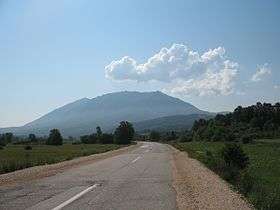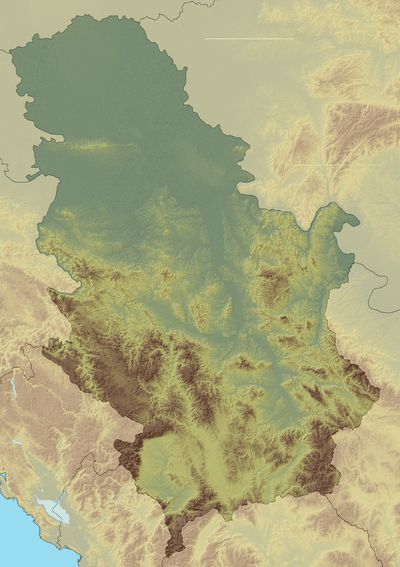Rtanj
| Rtanj | |
|---|---|
 Pyramidal shape of Šiljak | |
| Highest point | |
| Elevation | 1,565 m (5,135 ft) |
| Coordinates | 43°46′34″N 21°53′36″E / 43.77611°N 21.89333°ECoordinates: 43°46′34″N 21°53′36″E / 43.77611°N 21.89333°E |
| Geography | |
 Rtanj Location in Serbia | |
| Location | Eastern Serbia |
| Parent range | Serbian Carpathians |
Rtanj (Serbian: Ртањ, pronounced [r̩̂ːtaɲ]) is a mountain situated in eastern Serbia, approximately 200 km southeast of Belgrade, between towns of Boljevac on north and Sokobanja on south. It belongs to the Serbian Carpathians. Its highest peak is Šiljak (pronounced [ʃǐːʎak]) (1,565 m), a natural phenomenon of karst terrain.
The north side of the mountain is covered with forests and shrubs, full of autochthonous plant species and plenty of sources of potable water. A hunting ground covers 6368 ha. The most common prey are roe deer and wild boar.
History
According to a legend, the castle of a wizard was situated on Rtanj Mountain, in which a great treasure was guarded. However, the castle has disappeared within the mountain, trapping the wealthy sorcerer inside.
On the peak Šiljak, there is a now the ruins of a little chapel dedicated to St. George. It was built in 1932 by the wife of a former local miner. Today, the chapel is in ruins, as it was partly destroyed by dynamite, when treasure hunters tried to find the hidden gold. There is an initiative to reconstruct the chapel.
Fringe theories
In 1971, poet Miodrag Pavlović wrote a poem "Splendid wonder" (Divno čudo). Inspired by the folk myths from the area, Pavlović described Rtanj as an abode of the ancient Serbian gods. In the next decades, additionally influenced by the pyramidal shape of the mountain, Rtanj became popular among the fringe theories supporters. In the 21st century it became a place of regular gathering of the believers in paranormal, which organize groups, symposiums and "surveys" of the mountain.[1]
Most popular theory is that, due to its shape and other "observed" factors (precise pyramidal geometry, golden ratio math, wondrous natural life, strong electromagnetism with fine frequencies, endemic plants, healthy energy radiation, special climate, mystical cultural heritage, naturally radiation-ionized air, Tesla waves), the mountain had to be artificially built. Claims are made that it is a multi-dimensional portal, that a channel leads from the top of the mountain to below the ground being used as a launch pad for alien space ships and that Rtanj is an "oscillator and resonator of the subtle energy hubs".[1]
For some New Age believers, the pyramidal shape of the mountain is due to it containing an alien pyramid emitting mystical energies. Many people have flocked here prior to the predicted 2012 Mayan Doomsday, believing it will protect them.[1][2][3]
Rtanj tea
A widely known traditional product of Rtanj is the "Rtanj tea", a herbal tea made of winter savory. It is celebrated for its antiseptic and aromatic properties, and is allegedly an aphrodisiac,[4] which gave the plant a local moniker đipikur ("jump(ing)-dick").[1]
Allegedly, the plant also has bronchodilatory and antioxidant effect and the virility is enhanced because of the flavonoids which stimulate the production of testosterone.[1]
References
- 1 2 3 4 5 Slobodan Kljakić (5 August 2018). "Занимљива Србија: Ртањ и ртањско биће" [Interesting Serbia: Rtanj and Rtanj's Entity]. Politika-Magazin, No. 1088 (in Serbian). pp. 19–21.
- ↑ Matt Blake (11 December 2012). "Hotels sell out as dooms-dayers flock to ANOTHER mountain which believers say houses an 'alien pyramid with magic powers'". MailOnline. Retrieved 11 December 2012.
- ↑ Tanquintic-Misa, Esther (11 December 2012). "2012 Mayan Doomsday Countdown: Serbia's Mount Rtanj is Alternate Refuge". International Business Times. Archived from the original on 19 December 2012. Retrieved 11 December 2012.
- ↑ Rtanj bez čaja, Politika, 2008-03-29
External links
| Wikimedia Commons has media related to Rtanj. |